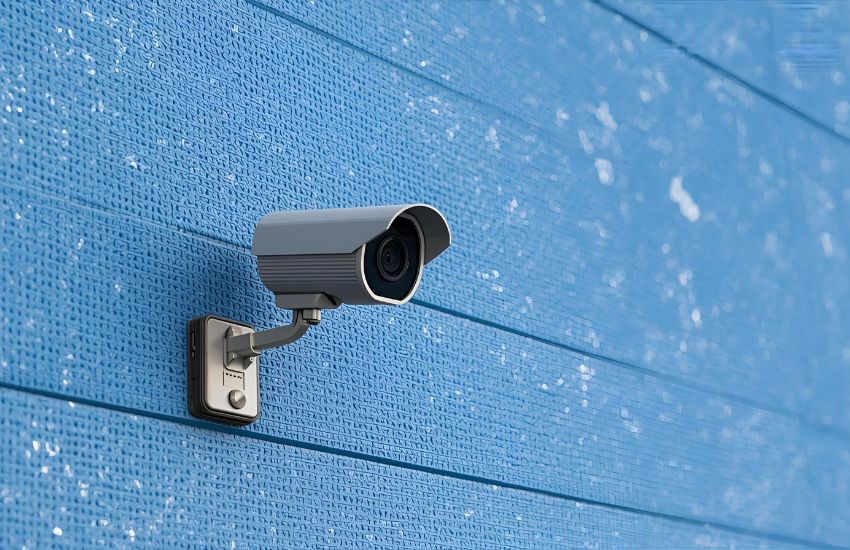Efficient management of your IP camera network is critical to maintaining high-quality surveillance without overloading your network bandwidth. As you integrate multiple cameras into your security camera system, understanding how bandwidth usage affects overall performance becomes essential. High-resolution cameras, such as 4K models, and higher frame rates significantly increase camera traffic, potentially causing network congestion and slower remote access.
To manage and optimize IP camera network traffic, adjust camera settings like resolution and frame rate to reduce bandwidth use. Use bandwidth calculators to estimate requirements accurately. Implement video compression and schedule recording during off-peak hours. Prioritize critical cameras on the network and ensure your infrastructure supports the total bandwidth consumption for a smooth, efficient security camera system.
This blog will guide you through strategies to manage and optimize IP camera network traffic. You will learn how to balance camera resolution, frame rates, and compression to maintain an efficient surveillance system, while also considering network connections and NVR setups to maximize performance and reliability.
Understanding IP Camera Bandwidth Usage and Network Requirements

What Is IP Camera Bandwidth and Why It Matters
When you operate an IP camera system, understanding IP camera bandwidth is crucial to ensure smooth and reliable performance. Bandwidth refers to the amount of data your IP camera network transmits over the internet or local network at any given time. High bandwidth consumption can cause delays, dropped frames, or even loss of connection, directly affecting your security camera system’s effectiveness. The quality of video streams, especially from a 4K camera, greatly influences how much bandwidth your system uses.
Factors Influencing IP Camera Bandwidth Consumption
Several variables impact your IP camera’s bandwidth consumption. Resolution, frame rate, compression methods, and the number of cameras streaming simultaneously all contribute to total network traffic. Higher resolution cameras or faster frame rates generate larger data streams, increasing bandwidth use. You need to balance these settings carefully to optimize both video quality and network efficiency.
How to Perform Bandwidth Calculation for Your System
Accurate bandwidth calculation helps you estimate your system’s data demands before installation or upgrades. You can use online bandwidth calculators specifically designed for IP cameras to determine expected IP camera bandwidth consumption based on your chosen settings. These tools factor in resolution, frame rate, compression, and the number of cameras to provide precise estimates of your network’s bandwidth requirements.
Strategies to Reduce Bandwidth Usage and Manage Network Traffic
To maintain an efficient IP camera network, you must manage and reduce excessive bandwidth usage. Employing advanced compression techniques can significantly decrease data size without compromising image quality. Adjusting frame rates during low-activity periods and limiting the use of high-resolution streams can further optimize your security camera system’s performance. Effective bandwidth management not only improves network stability but also reduces storage costs related to bandwidth and storage.
By understanding your IP camera bandwidth and network needs, you position yourself to design a robust IP video surveillance setup that meets both performance and operational goals.
See more about…IP Cameras with Long Range Wireless Bridge
Smart Strategies to Reduce IP Camera Bandwidth Consumption

Effectively managing your IP camera data usage is vital for maintaining a stable and reliable security system. The amount of data generated by cameras, especially those with 4K resolution or multiple 1080p cameras, can place a significant strain on your network infrastructure and overall network performance. Understanding how much bandwidth your cameras require allows you to optimize your setup and reduce unnecessary network traffic.
One key approach is to carefully consider camera placement. Positioning cameras to cover essential areas without overlapping excessive fields of view helps reduce redundant video traffic. Additionally, leveraging camera features such as motion detection enables your system to record or stream only when activity is detected, which can significantly reduce bandwidth consumption.
Implementing a network switch optimized for handling video traffic and distributing bandwidth efficiently ensures better allocation of network resources. Using compression standards like H.264 can also reduce your IP camera’s data usage without sacrificing image quality. This effective bandwidth management lowers your camera internet and upload bandwidth demands, preventing bottlenecks that could degrade your video surveillance systems.
Regular bandwidth calculation for IP cameras and understanding the speed needed for security cameras on your network empowers you to reduce your IP camera bandwidth consumption. Balancing camera resolution, frame rates, and the number of cameras connected to your cameras and NVR setup further optimizes your system. By applying these smart strategies, you ensure an efficient use of internet usage and network resources, maintaining a high-performing IP security network that meets your surveillance needs without requiring more bandwidth than necessary.
See more about…IP Camera Network Traffic
Tools and Techniques for Bandwidth Calculation in CCTV Systems

Understanding Bandwidth in Modern IP CCTV Systems
In today’s security industry, managing the amount of bandwidth your CCTV cameras require is crucial for maintaining optimal system performance. Each network video camera, especially a 4MP IP or other modern IP models, continuously use bandwidth all the time when transmitting data over a network. This constant data transmission can significantly impact your overall network, especially if you have multiple cameras installed or operate a large home security setup.
Importance of Accurate Bandwidth Usage Calculation
You need to understand how much bandwidth your IP cameras will use bandwidth to avoid overwhelming your existing network or slowing your connection to the internet. Proper usage calculation ensures you allocate sufficient resources for flexible monitoring without compromising video quality. For instance, cameras streaming at 15 frames per second will demand more bandwidth than those at lower frame rates, affecting megabits per second required by your system.
Tools for Bandwidth Calculation
Using an IP camera bandwidth calculator or specialized tools designed for internet protocol video can simplify this process. These calculators factor in variables like resolution, frame rate, compression method, and number of cameras to estimate the data over a single ethernet or wireless connection. This helps you plan the use network capacity effectively and determine the internet speed needed for security without guesswork.
Techniques to Optimize Data Over Your Network
Beyond calculation, monitoring actual data over a network helps you adjust settings such as resolution, frame rate, and compression to balance quality with bandwidth efficiency. Ensuring your cameras do not use bandwidth all the time unnecessarily can prevent congestion on your overall network and improve performance across all connected devices.
By mastering these tools and techniques, you gain better control over your CCTV system’s bandwidth demands, ensuring reliable, high-quality surveillance tailored to your network’s capacity.
See more about…IP67 Security Camera
Conclusion
Accurate ip camera bandwidth calculation is essential for designing an efficient security camera system that meets your bandwidth requirements without overwhelming your ip camera network. Understanding bandwidth consumption helps you manage the significant data usage generated by high-resolution devices like a 4K camera or a standard CCTV camera. Utilizing reliable bandwidth calculators and an ip camera bandwidth calculator allows you to estimate security camera bandwidth needs precisely, ensuring smooth operation and avoiding network congestion. By monitoring and optimizing your ip camera network and bandwidth consumption, you can maintain high-quality surveillance while effectively controlling data usage and overall system performance.
See more about…IP Camera Alarm Output
Frequently Asked Questions (How to Manage and Optimize IP Camera Network Traffic for Efficient Surveillance)
How to reduce IP camera bandwidth?
To reduce IP camera bandwidth, lower the video resolution, frame rate, or bit rate in the camera settings. Enable video compression formats like H.265 instead of H.264 for more efficiency. Use motion detection recording instead of continuous recording. Adjust image quality settings and disable unnecessary audio streams to optimize bandwidth usage without losing critical footage.
How to manage an IP camera?
To manage an IP camera, connect it to your network, access its interface via a web browser or mobile app, and configure settings like resolution, motion detection, and recording schedules. Regularly update firmware for security, adjust bandwidth usage, and set strong passwords. Use NVR or cloud storage for monitoring, playback, and efficient video management.
What factors should you consider when deciding between an analog camera and an IP camera?
When deciding between an analog camera and an IP camera, consider resolution quality, installation cost, scalability, and features. Analog cameras are cheaper and easier to install with coaxial cables but offer lower resolution. IP cameras provide higher image quality, remote access, advanced features like analytics, and easier integration, but they require higher bandwidth and cost more.
How to calculate bandwidth requirements for IP camera?
To calculate bandwidth requirements for an IP camera, multiply the camera’s resolution (pixels) by frame rate (fps) and bit depth, then factor in compression (H.264/H.265). The formula is: Bandwidth = (Resolution × FPS × Bit Depth × Compression Ratio). Always add overhead for multiple cameras, streaming, and storage, typically increasing the estimate by 10–20%.
